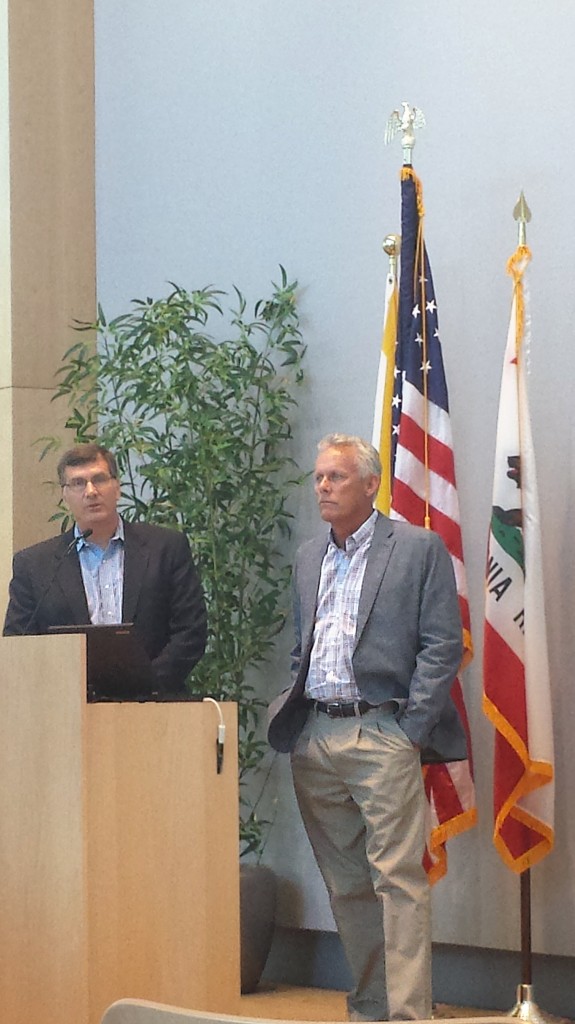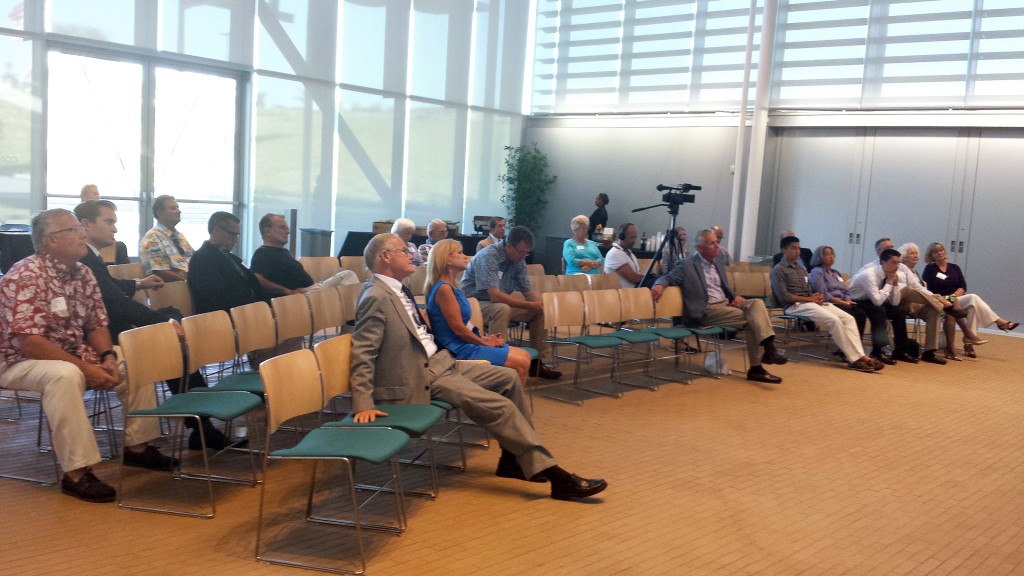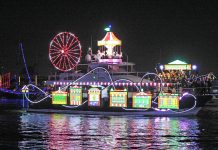About two dozen people heard updates from officials at a meeting this week about two potential programs for the harbor.
Harbor commissioners Brad Avery and Dave Girling gave presentations on both the water taxi and the multiple vessel mooring system pilot projects during a Speak Up Newport meeting on Wednesday.

— NB Indy Photo ©
Both commissioners are on the ad hoc subcommittees tasked with researching the pilot program ideas. Avery is working on the mooring system and Girling on the water taxi.
They’re exploring the ideas to see what would add value for all users of the harbor.
“We really do endeavor in our efforts through these subcommittees to make sure what we’re looking into benefits everybody,” Girling said.
“That’s the most critical thing about this,” Avery agreed. “The reason we’re doing it, and sometimes people forget, is to benefit everyone in the harbor area… All the users.”
Both issues are being looked into at the request of Mayor Rush Hill as two of his three initiatives for 2014. His third is a public golf course at the old Coyote Canyon Landfill site.
The water taxi idea has been discussed before and once again is a hot topic.
The concept of a water taxi or bus was explored in 2009, Girling explained, and the current committee used the report as a starting point for much of their research.
“There appears to be significant interest in a public water-borne transportation system in Newport Harbor. Everyone thinks it’s a great idea,” Girling said. “However, estimating the actual demand or ridership for such a system was really beyond the scope of our committee, but it’s really imperative to the process.”
Although the committee did conclude that the demand for the service would be seasonal.
Cost estimates include $150,000 per vessel, $35 per hour for captains, $25 per hour for deck hands, plus “significant capital cost for dock reconfiguration” for several docks to become ADA compliant and other costs for signage, marketing and more.
A water taxi, or “on demand,” service would not be practical because of the size of the harbor and the speed limit, Girling explained, at least not in the early stages.
A scheduled loop route “water bus” service would be more feasible, he added. That could include “flag stops,” flagging it down along the scheduled route.
Eventually, after the pilot program, a hybrid model of both methods could develop using Uber-like technology, he noted.
They are “virtually certain” that a water bus service could not break even on fare revenue, Girling said. It might be possible with other sources of revenue, he added, which might include advertising aboard the vessels and contributions from harbor area businesses benefiting from the passenger traffic.
It would also likely need to be subsidized, he continued, which could have an impact on current harbor operators.
There was some concern it might turn into a tour operating system, rather than strictly a taxi or bus system, he said.
In order to have a successful pilot program, committee members felt that they would need at least four boats to achieve an adequate service level. There would be two pairs traveling in opposite directions on a 90 minute loop.
If the council decides to move forward with it, they hope to have something in place by next summer, Girling said.
Both pilot programs are expected to be presented for review to the council in October.
Avery spoke to the crowd about the multiple vessel mooring system.
“Really what it is, it’s just putting a float, if you will, between two boats in the mooring field,” Avery explained.
The purpose of the project is to increase amenities, and reduce the footprint of boats in the harbor, therefore increasing the usable water space.
“The objective of this was to just come up with a proposal to do a temporary study, perhaps build a few docks, put them in the water and just let it roll forward and see what people thought,” Avery said.
Findings from the committee included that there should not be any pilings for the temporary pilot project – as that would be too permanent, no water or electricity, and have a work/wash-down float.
“The idea is to keep it simple, keep it low cost and see how it goes,” Avery said.

— NB Indy Photo ©
Anchor options include the existing buoy, weight and chain method, Helix anchor and elastic band method, or a hybrid of the two.
The Helix system is steadier than the current system, but “a little more complex and a little more expensive,” Avery said.
The committee concluded that six floats, 40 to 50 feet long and 6 feet wide, should be installed. They also found that three floats should be fitted with the current weight system and three with the Helix (or hybrid) method. A sea lion deterrent should also be included.
They also recommends that the pilot program run for two summers. Community members and harbor users would be surveyed during and after the conclusion of the pilot program.
Possible locations include C, D, H and J fields. Only existing permittees that volunteer for the pilot project would be used, Avery clarified. There would be no charge for the floats.
The total estimated cost is $248,000, according to Avery. Each float would cost about $35,000, engineering approximately $20,000 and $3,000 per float for sea lion deterrents.
“That’s the plan, that’s what we came up with,” Avery concluded. “The question is: How do the mooring permittees feel about it? Is there a demand?”
The Newport Mooring Association, whose members include about half of the 850 mooring permit holders, sent out a poll on the subject.
The survey returned 85 percent negative results on the floating docks concept, Avery said.
Only 11 out of 54 responders said they would volunteer their mooring for the pilot program, according to the NMA poll.
The top priority of those surveyed was to have a short-side work dock to be able to charge batteries, stay overnight, allow for light mechanic work
After hearing the presentation in June, City Council directed Harbor Resources Manager Chris Miller to conduct a survey of homeowners, mooring permittees and others interested in the harbor. It is currently underway and results should be available within the next month or so.
During the Harbor Commission meeting later Wednesday night, Miller gave an update on the survey. It was distributed to about 4,000 people, he explained, including homeowners, mooring permittees and other harbor users. Approximately 200 people have responded so far.
“Skimming through these results…They are heavily weighted in the ‘No’ category,” he said. “That it’s not something that, at least those three user groups, wanted.”
The results will be compiled and presented to the city council in September.
For more information, visit speakupnewport.org and newportbeachca.gov.




